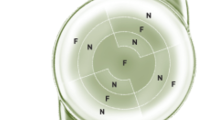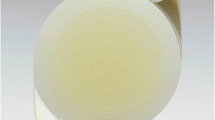Abstract
Fifty-two eyes of 26 bilateral patients underwent cataract surgery with AcrySof IQ PanOptix implantation. Distance and near visual acuities, contrast sensitivity, defocus curve, ocular optical performance with the light distortion analyzer and the near activity visual questionnaire (NAVQ) were evaluated.
A significant improvement after surgery in distance and near visual acuities was observed (p < 0.05). Contrast sensitivity outcomes are within the normal range for the same age sample for all spatial frequencies. Defocus curve for the trifocal IOL shows a visual acuity equal to or better than 0.30LogMAR between defocus levels of +0.50 and −3.00D.
This IOL provides excellent visual outcomes for distance intermediate and near vision. Contrast sensitivity values are within the normal limits for this multifocal IOL model.
Access provided by Autonomous University of Puebla. Download chapter PDF
Similar content being viewed by others
Keywords
1 Introduction
Trifocal IOLs were developed to solve the compromise of the intermediate vision provided by bifocal IOLs. The AcrySof PanOptix trifocal IOL (Alcon Surgical, Inc.) seeks low pupillary dependence and aims to improve intermediate vision with a substantial range and an optimal one at 60 cm, the distance most used recently in daily life with the massive development and rising usage of handheld devices and computers.
1.1 The AcrySof IQ PanOptix Trifocal IOL
This trifocal IOL is a single-piece biconvex design and is made with hydrophobic material. Its optical size is 6.0 mm, with an overall diameter of 13.0 mm. The optic is aspheric with a diffractive structure in the central 4.5 mm portion (15 diffractive zones) and an outer refractive zone to give three focal points for distance, intermediate and near vision (Fig. 20.1). The near addition of the AcrySof IQ PanOptix is +3.25 D for the near focus and + 2.17 D addition for the intermediate focus at the IOL plane [1,2,3].
1.2 Clinical Experience
1.2.1 Patients
Fifty-two eyes of 26 bilateral patients were included in this study with age ranging between 47 and 76 years. Patients analysed were candidates for cataract surgery and had no other active ocular diseases that might influence the visual outcome.
1.2.2 Preoperative and Postoperative Examination
Preoperatively, all patients had a full ophthalmologic examination, including the evaluation of the refractive status, assessment of the distance and near visual acuities, slit lamp examination, tonometry and funduscopy. Other specific examinations were performed: corneal topography (Sirirus, Costruzione Strumenti Oftalmici) and biometry (IOL Master, Zeiss).
Postoperatively, patients were evaluated during 6 months after surgery. The postoperative examination protocol was identical to the preoperative protocol, with the measurement of the intermediate visual acuity at 80 cm, defocus curves, and contrast sensitivity with the Pelli-Robson test in photopic conditions; postoperative ocular aberrations were measured with the Osiris aberrometer; light distortion was evaluated using the light distortion analyser [4]; and the near activity visual questionnaire (NAVQ) was evaluated preoperatively and in the 3-month visit. The light distortion analyser is a device consisting of a central white light-emitting diode (LED) surrounded by 240 small, white LEDs distributed in 24 semimeridians. Peripheral stimuli (the smaller LEDs) are presented around the central source of light from the inner to the outer part of the test field. The test was performed first monocularly and then binocularly. The software calculates several indices that determine the size and regularity of the distortion surrounding the central source of light. The distortion index (DI) is calculated as the ratio of the area of points missed by the subject and the total area explored and is expressed as a percentage. The best-fit circle radius (BFCR) is defined as the circle that best fits the distortion area resulting from the linear binding of all points in each meridian of the device in millimetres. The deviation of the obtained polygonal shape from the best-fit circle fit is called the best-fit circle irregularity (BFCI) [4].
1.3 Results
1.3.1 Visual and Refractive Outcomes
Uncorrected (UDVA), corrected distance (CDVA) and uncorrected near (UNVA) visual acuities improved with the surgery (p ≤ 0.01) and did not change during the follow-up (p ≤ 0.09). Distance-corrected near visual acuity (DCNVA), uncorrected (UIVA) and distance corrected (DCIVA) intermediate visual acuities were stable during the follow-up (p ≥ 0.14). These outcomes were in concordance with previous studies (Table 20.1) [1,2,3, 5,6,7,8,9,10,11,12,13,14,15].
1.3.2 Contrast Sensitivity Outcomes
Monocular and binocular contrast sensitivity at 3 months after surgery was 1.58 ± 0.18 and 1.86 ± 0.15 log units, respectively. These outcomes were similar that of other multifocal or monofocal IOLs [16, 17].
1.3.3 Defocus Curve
Defocus curve shows that this trifocal IOL provides a visual acuity equal to or better than 0.30LogMAR between defocus levels of +0.50 and −3.00D (Fig. 20.2). The defocus curve of this trifocal IOL is similar to that obtained with this type of IOL [2, 7, 9,10,11,12,13,14].
1.3.4 Optical Quality Outcomes
Figure 20.3 shows the internal aberrations at 5.0 mm of pupil obtained with a pyramidal aberrometer. Table 20.2 shows the light distortion indices. DI was reduced significantly when the measurement was done in binocular conditions (p = 0.03). Figure 20.4 shows an example of the measurement with the light distortion analyser. Distortion indices obtained with PanOptix IOL were lower than another trifocal IOL and higher than a monofocal IOL reported in a previous investigation [4].
1.3.5 Near Activity Visual Questionnaire
The mean Rasch score of the NAVQ was 67.18 ± 20.64 and 20.21 ± 9.20 logits (0 = completely satisfied, 100 = completely unsatisfied) preoperatively and at 3 months after surgery, respectively (p < 0.01).
2 Conclusions
The AcrySof IQ Panoptix IOL is able to restore the visual function in far, intermediate and near distances after cataract surgery with acceptable contrast sensitivity. After implantation of this IOL, patients improve the quality of their near visual activity.
Advantages
-
It restores the distance near and intermediate visual function after cataract surgery.
-
It provides acceptable low mesopic contrast sensitivity function, better than other lenses from the Alcon Family.
-
Patients improve the quality of their near visual activity with the surgery.
Disadvantages
-
Distortion indices were higher than in a monofocal IOL.
-
Near vision is insufficient in some cases, leading to the use of near vision spectacles.
Compliance with Ethical Requirements
Ana B. Plaza-Puche and Jorge L. Alió declare that they have no conflict of interest. All procedures followed were in accordance with the ethical standards of the responsible committee on human experimentation (institutional and national) and with the Helsinki Declaration of 1975, as revised in 2000. Informed consent was obtained from all patients for being included in the study. No animal studies were carried out by the authors for this chapter.
References
Lawless M, Hodge C, Reich J, et al. Visual and refractive outcomes following implantation of a new trifocal intraocular lens. Eye Vis. 2017;4:1–6.
García-pérez JL, Gros-otero J, Sánchez-Ramos C, et al. Short term visual outcomes of a new trifocal intraocular lens. BMC Ophthalmol. 2017;17:1–9.
Gundersen K, Potvin R. Trifocal intraocular lenses : a comparison of the visual performance and quality of vision provided by two different lens designs. Clin Ophthalmol. 2017;11:1081–7.
Brito P, Salgado-Borges J, Neves H, et al. Light-distortion analysis as a possible indicator of visual quality after refractive lens exchange with diffractive multifocal intraocular lenses. J Cataract Refract Surg. 2015;41:613–22.
Kohnen T, Titke C, Bohm M. Trifocal intraocular lens implantation to treat visual demands in various distances following Lens removal ¨. Am J Ophthalmol. 2016;161:71–7.
Marques J, Rosa A, Quendera B, et al. Quantitative evaluation of visual function 12 months after bilateral implantation of a diffractive trifocal IOL. Eur J Ophthalmol. 2015;25:516–24.
Monaco G, Gari M, Di Censo F, et al. Visual performance after bilateral implantation of 2 new presbyopia-correcting intraocular lenses: trifocal versus extended range of vision. J Cataract Refract Surg. 2017;43:737–47.
Bilbao-Calabuig R, Llovet-Rausell A, Ortega-Usobiaga J, et al. Visual outcomes following bilateral implantation of two diffractive trifocal intraocular lenses in 10 084 eyes. Am J Ophthalmol. 2017;179:55–66.
Mojzis P, Peña-García P, Liehneova I, et al. Outcomes of a new diffractive trifocal intraocular lens. J Cataract Refract Surg. 2014;40:60–9.
Ruiz-Mesa R, Abengózar-Vela A, Aramburu A, et al. Comparison of visual outcomes after bilateral implantation of extended range of vision and trifocal intraocular lenses. Eur J Ophthalmol. 2017;26(27):460–5.
Alió JL, Montalbán R, Peña-García P, et al. Visual outcomes of a trifocal aspheric diffractive intraocular lens with microincision cataract surgery. J Refract Surg. 2013;29:756–61.
Mojzis P, Kukuckova L, Majerova K, et al. Comparative analysis of the visual performance after cataract surgery with implantation of a bifocal or trifocal diffractive IOL. J Refract Surg. 2014;30:666–72.
Plaza-Puche AB, Alio JL. Analysis of defocus curves of different modern multifocal intraocular lenses. Eur J Ophthalmol. 2016;4(26):412–7.
Alió JL, Plaza-Puche AB, Alió Del Barrio JL, Amat-Peral P, Ortuño V, Yébana P, Al-Shymali O, Vega-Estrada A. Clinical outcomes with a diffractive trifocal intraocular lens. Eur J Ophthalmol. 2018;28:419–24.
Kohnen T, Herzog M, Hemkeppler E, Schönbrunn S, De Lorenzo N, Petermann K, Böhm M. Visual performance of a Quadrifocal (trifocal) intraocular Lens following removal of the crystalline Lens. Am J Ophthalmol. 2017;184:52–62.
Mäntyjärvi M, Laitinen T. Normal values for the Pelli-Robson contrast sensitivity test. J Cataract Refract Surg. 2001;27:261–6.
Thiagarajan M, McClenaghan R, Anderson DF. Comparison of visual performance with an aspheric intraocular lens and a spherical intraocular lens. J Cataract Refract Surg. 2011;37:1993–2000.
Author information
Authors and Affiliations
Corresponding author
Editor information
Editors and Affiliations
Rights and permissions
Copyright information
© 2019 Springer Nature Switzerland AG
About this chapter
Cite this chapter
Plaza-Puche, A.B., Alió, J.L. (2019). Multifocal Intraocular Lenses: AcrySof IQ PanOptix Trifocal Lens. In: Alió, J., Pikkel, J. (eds) Multifocal Intraocular Lenses. Essentials in Ophthalmology. Springer, Cham. https://doi.org/10.1007/978-3-030-21282-7_20
Download citation
DOI: https://doi.org/10.1007/978-3-030-21282-7_20
Published:
Publisher Name: Springer, Cham
Print ISBN: 978-3-030-21281-0
Online ISBN: 978-3-030-21282-7
eBook Packages: MedicineMedicine (R0)








